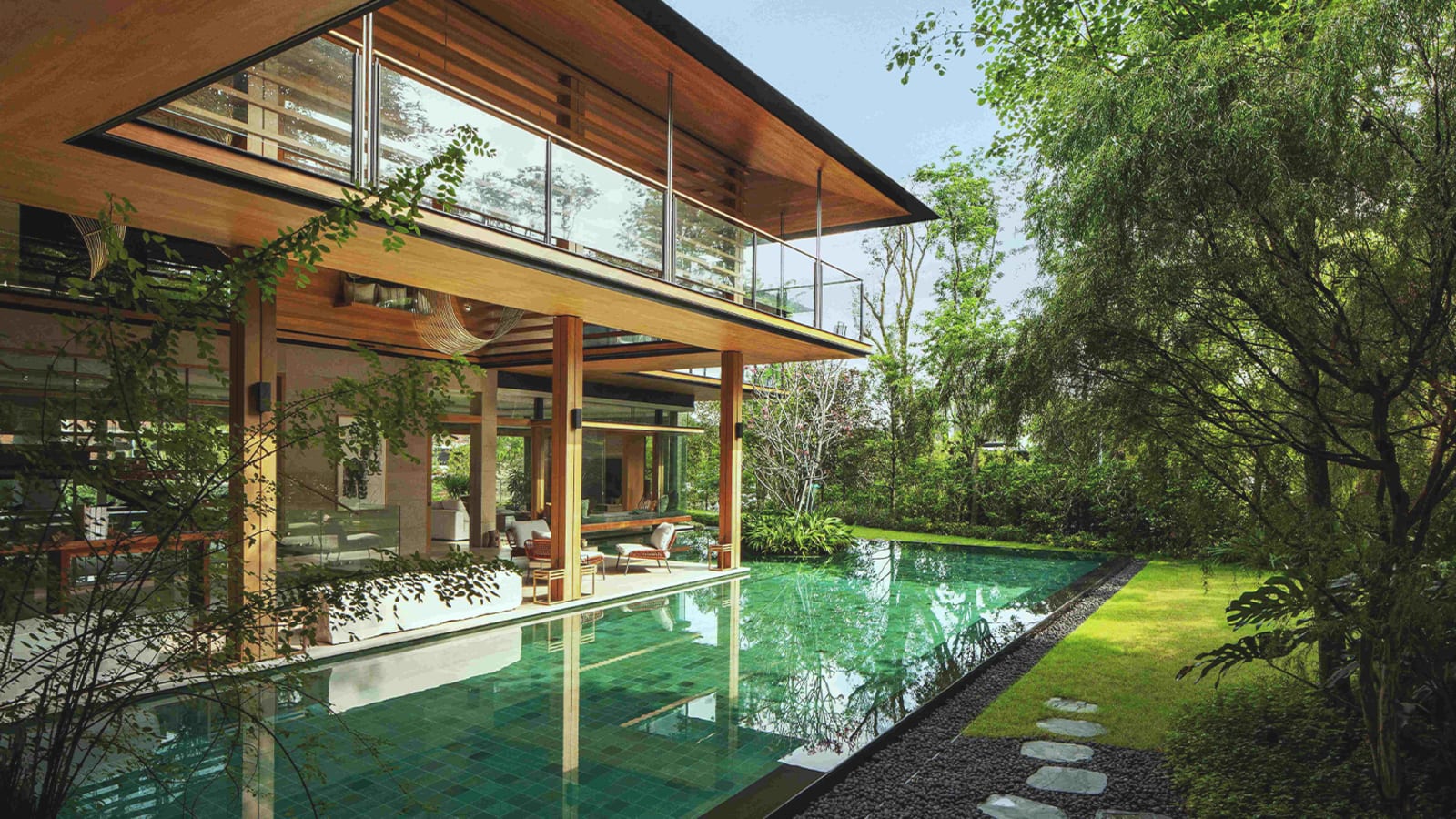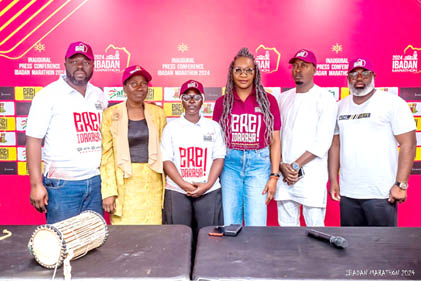When the owner of this house in Singapore wakes up in the morning, she is greeted by greenery outside the full-height glass windows. Elevated on the second storey, a sheltered path meanders around the perimeter of her bedroom, edged by landscaping. Beyond, the crown of tall trees – both in her estate and those of neighbours with equally lush gardens – add to the bucolic view.
The house is designed by Guz Architects, whose approach delivers on both scenic and comfortable tropical architecture . Greenery is always the protagonist, experienced as part of the built form rather than outside of it or as an afterthought; almost every space has views of gardens and access to semi-sheltered outdoor spaces. Rejecting the house as a gloried showpiece, the owner wanted it to be a retreat for her family, offering tranquillity and a sense of rest.

“This is her dream home because her former houses were much smaller,” said Cherin Tan, founder and creative director of LAANK, who was engaged for the interior design. This project is an anomaly in Tan’s portfolio, as the firm is known more for its commercial and hospitality works such as Violet Oon’s Peranakan restaurants and the recently opened Roia in the 1912-built EJH Corner House at the Singapore Botanic Gardens. In her choice of furniture and tactual materials for the bathrooms, it is clear that Tan is as adept at creating nuanced domestic projects as she is working with brands.
The large footprint of this Good Class Bungalow (GCB) means not only more generously sized rooms but also ample space for gardens, which contribute to the feeling of escaping from work and urban life. “When we design a house, we always try to ensure that its footprint is not too large that we cannot have generous roof overhangs – essential for protection from Singapore’s hot and rainy climate,” added Guz Wilkinson, the founder of his eponymous architecture firm, Guz Architects. The pitched roof is a characteristic feature of the buildings Wilkinson designs, like modernised versions of vernacular kampong houses and black-and-white bungalows.
They also function in a similar manner, with most spaces having the option of being naturally ventilated even during rainfall due to the extended canopies and roof overhangs. As this house is on sloped terrain, the road is level with the basement. Here is where Wilkinson tucked the garage, a lounge and the gym.
Elevated, the main living spaces enjoy added privacy. From the road, the building looks like it is sitting on a green mound, with the landscaped walls of the basement meeting the rise of the garden that slopes up to the first storey. It turns the corner to meet a sprawling garden facing the other side of the plot.
“As the site is very prominent, protruding out on a raised plot onto a road, we decided that it would be better turning the back of the house to this road to instead focus on the more private garden to the rear,” Wilkinson highlighted.The garden can also be accessed by a staircase and elevator at the basement, where Tan made a very welcoming lounge decorated with refined yet cosy composition of plush furniture and artwork. “We seamlessly blended into the sophisticated architecture natural elements such as wood and stone, alongside the comforts of modern living and personalisation of spaces,” she shared.
Tan highlighted that the homeowner’s aesthetic leans toward a “hybrid style merging Taiwanese, Japanese and contemporary influences in interior design”. This translates to elegance, timelessness, meticulous attention to detail, simplicity, balance and a celebration of the beauty of imperfection, found in elements like a screen from B&B Italia made of rusted metal at the lounge. Similarly, the palette of earth, grey and sand for the furnishing is inspired by nature, which the homeowner enjoys being surrounded by.
These are matched with softer materials like fabric for the wardrobe doors “because in a big house like this, there are a lot of harsh surfaces,” Tan remarked. Another request from the owner was to honour her Hakka roots in a modern way. “She is very appreciative of the arts,” described Tan.
In the lounge, a painting by contemporary local Hakka artist Tay Bak Chiang, embellishes the walls with minimal strokes. It is complemented by a trio of paper sculptures made from old books from Italian studio Crizu, lit by light falling through gaps in the staircase designed by Wilkinson to appear as if it is floating. Up this staircase, a generous foyer separates the homeowner’s study from the living and dining areas.
Here a wonderful view of the garden and pool greets guests. Within the landscaping, the leaves of Willow trees dip low like green lace curtains, creating a picturesque scenery. Timber slats at the upper level of this double-volume space filter glare and heat, while the high ceiling and pool lower ambient temperature.
It is a pleasant space to linger in, crowned by a steel chandelier from Million Lighting dancing in the void, as if blown by the breezes that cool the timber-clad space. This area functions similarly to the verandahs of black-and-white houses – as a casual, comfortable space for admiring the garden. Overlooking the foyer, the corridors to the bedrooms are also naturally ventilated.
They continue outside this void to become sheltered pathways, bordered by landscaping. The main staircase leading from the first storey to the second, as well as the corridors outside the bedrooms are naturally ventilated. At the attic, Wilkinson capped the house with a “sky pavilion” that mitigates the house’s mass.
“It was designed to scoop up the evening breezes as it is at the higher attic level,” he commented. The timber-clad ceiling rises upward dramatically, following the slope of the pitched roof. Here Wilkinson decided to incorporate a bench along the bench, adorned with cushions chosen by Tan.
It provides seating for a large number of people during gatherings that can spill out into the garden. Against the backdrop of sculpted trees in the surrounding garden , barbecues are relaxing and convivial. Outside, stone steps beckon outdoor ambles in the beautifully landscaped roof garden – a device often deployed by Wilkinson in his projects to cool the spaces below.
On the sky pavilion’s roof, solar panels help offset energy use. Tan shared that in dressing the home, she continued with the homeowner’s wish to honour her Hakka heritage and looked to traditional Hakka walled houses (or tulou) that celebrate community and kinship. “Embracing the concept of shared spaces and intimate gatherings, the house’s furnishing selections and layouts are cosy and inviting, encouraging family members to come together, promoting unity and connection across generations,” Tan said.
In the living area, she chose a curved sofa that instinctively encourages interaction. A seating arrangement by the pool is another spot to observe and chat. The owner’s appreciation of family life is also evident in the kitchen, where an impressive industrial stovetop of six facilitates many shared meals, whipped up daily and enjoyed at the long dining table.
Along this space, Wilkinson has created a horizontal timber screen to display the homeowner’s collection of craft objects. To the mix, Tan suggested pieces from local ceramics boutique Artifact that include charcoal-coloured bowls by Singaporean artist Leng Soh, echoing the house’s artistic, tactile sensibility. Throughout the length of the living and dining areas, glass sliding doors open to a linear garden so that when lounging or taking meals, the family is always surrounded by nature.
Likewise, Wilkinson cut a picture window in the study to strategically frame a Bonsai and planted a bamboo grove outside the windows of a bedroom on the first storey. It is obvious that for this family, one need not go far to disconnect from city life. Wilkinson’s ‘breathing’ architecture incorporating plentiful passive green strategies creates a healthy living environment and offers nature as an antidote to urban stresses.
Tan’s approach is in line with Wilkinson’s biophilic architectural ethos, similarly intentional and reverent “for the present moment,” stated Tan. “Our interior design also integrates biophilic design principles to create a connection with the natural world.”.



















